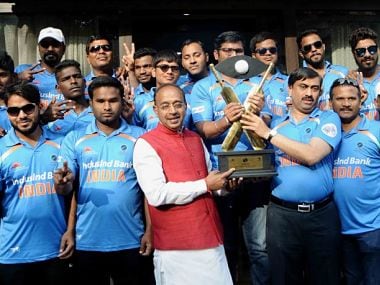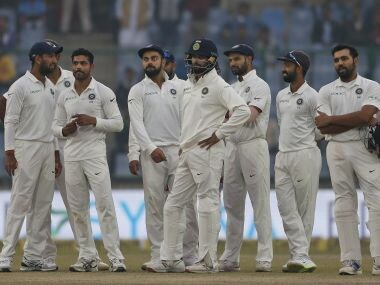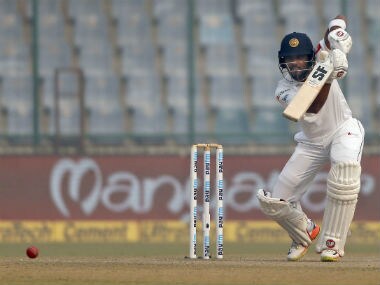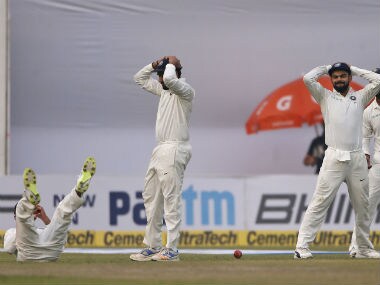IPL retention rules: From Right to Match cards to new salary cap, a handy explainer of latest regulations
As per the new IPL policy, franchises can retain up to five players using a combination of pre-auction retentions and Right to Match (RTM) cards.
FirstCricket Staff, Dec, 07 2017
- ICC World Cricket League Championship, 2015/17 HK Vs PNG Hong Kong beat Papua New Guinea by 23 runs
- Afghanistan and Ireland in UAE, 3 ODI Series, 2017 AFG Vs IRE Afghanistan beat Ireland by 138 runs
- Sri Lanka in India, 3 Test Series, 2017 IND Vs SL India drew with Sri Lanka
- The Ashes, 2017/18 AUS Vs ENG Australia beat England by 120 runs
- West Indies in New Zealand, 2 Test Series, 2017 NZ Vs WI New Zealand beat West Indies by an innings and 67 runs
- Afghanistan and Ireland in UAE, 3 ODI Series, 2017 AFG vs IRE - Dec 7th, 2017, 11:30 AM IST
- ICC World Cricket League Championship, 2015/17 HK vs PNG - Dec 8th, 2017, 11:30 AM IST
- West Indies in New Zealand, 2 Test Series, 2017 NZ vs WI - Dec 9th, 2017, 03:30 AM IST
- Sri Lanka in India, 3 ODI Series, 2017 IND vs SL - Dec 10th, 2017, 11:30 AM IST
- Afghanistan and Ireland in UAE, 3 ODI Series, 2017 AFG vs IRE - Dec 10th, 2017, 11:30 AM IST
| Rank | Team | Points | Rating |
|---|---|---|---|
| 1 | India | 4969 | 124 |
| 2 | South Africa | 3767 | 111 |
| 3 | England | 4497 | 105 |
| 4 | New Zealand | 3114 | 97 |
| 5 | Australia | 3294 | 97 |
| Rank | Team | Points | Rating |
|---|---|---|---|
| 1 | South Africa | 6386 | 120 |
| 2 | India | 6379 | 120 |
| 3 | Australia | 5948 | 114 |
| 4 | England | 6156 | 114 |
| 5 | New Zealand | 5432 | 111 |
| Rank | Team | Points | Rating |
|---|---|---|---|
| 1 | Pakistan | 2843 | 124 |
| 2 | New Zealand | 1925 | 120 |
| 3 | West Indies | 2395 | 120 |
| 4 | England | 2029 | 119 |
| 5 | India | 2965 | 119 |





The Indian Premier League (IPL) Governing Council and Committee of Administrators (CoA) met on Wednesday to finalise the retention policy for the 2018 season of the cash-rich league.
MS Dhoni is all set to return to CSK in the 2018 edition of IPL . BCCI
As per the new policy, franchises can retain up to five players using a combination of pre-auction retentions and Right to Match (RTM) cards. The teams can use either option for a maximum of three times, which means even if a team doesn’t opt for a pre-auction retention, it can use RTM cards to retain a maximum of three players only and not five.
The dates of auction, however, are yet to be announced.
Following are the key takeaways:
What is pre-auction retention?
This allows franchises to retain a maximum of three players, before the actual auction. Players retained using this route will thus not be part of the IPL auction. Teams can use this method to retain their three most important players.
The cost of capped players who can be retained pre-auction are:
If the franchise retains three players: The cost of players will be Rs 15 crore, Rs 11 crore and Rs 7 crore respectively. The money — Rs 33 crore — will be deducted from their auction purse.
If the franchise retains two players: The cost will be Rs 12.5 crore and Rs 8.5 crore respectively. Rs 21 crore will be deducted from their auction purse.
If the franchise retains one player: The cost will be Rs 12.5 crore. The money will be deducted from franchise’s auction purse.
Retention of an uncapped player will cost Rs 3 crore, which again will be deducted from franchise’s auction purse.
What is RTM?
The latest entrant to the auction table, Right to Match cards enable a franchise to ‘match’ the auction price offered for its player (who they did not retain pre-auction) by a rival franchise to retain that player.
For example, if Krunal Pandya, who played for Mumbai Indians in the last season but does not figure among the three pre-auction retainees, is bought by Delhi Daredevils for Rs 5 crore, MI can use their RTM to retain Pandya for Rs 5 crore.
What happens to Chennai Super Kings (CSK) and Rajasthan Royals (RR)?
The two franchises were suspended for two years in 2015 by the Supreme Court-appointed Justice Lodha-led panel. They were replaced by Rising Pune Supergiants (RPS) and Gujarat Lions (GL). CSK and RR will return to the IPL fold while RPS and GL will cease to exist. The new retention policy ensures CSK and RR can retain their most important players.
What about players who were part of RPS and GL?
Players who were part of the CSK/RR teams and then joined RPS/GL will be open for retention. For example, CSK can retain three players before the auction, and use RTM to get back two more of their former players at auction, if it so desires. Players who are not retained will return to auction pool.
Players from CSK/RR who joined franchises other than RPS/GL will either go back to the auction pool, or can be retained (pre-auction)/RTM by current franchises (not CSK/ RR).
Players who have played only for RPS or GL will return to auction pool. For example, Ben Stokes, who made his IPL debut last season for RPS at Rs 14.5 crore, will be open for auction for all teams.
Players who CSK can retain: MS Dhoni, R Ashwin, Faf du Plessis, Baba Aparajith, Ankush Bains, Suresh Raina, Ravindra Jadeja, Dwayne Bravo, Brendon McCullum, Dwayne Smith, Andrew Tye, Irfan Pathan and Ishwar Pandey.
Players who RR can retain: Ajinkya Rahane, Steven Smith, Ankit Sharma, Rajat Bhatia, James Faulkner and Dhawal Kulkarni.
What is the new salary cap?
Some new auction records can be set for the 2018 edition as salary cap has been increased from Rs 66 crore to Rs 80 crore. The cap for 2019 will be Rs 82 crore and for 2020 will be Rs 85 crore. The franchises will have to spend at least 75% of the salary cap each season.
The base price of capped and uncapped players has been revised as well. Previously, the three categories of uncapped Indian players had a base price of Rs 10, 20 and 30 lakh respectively. Each category has been propped up by Rs 10 lakh.
For capped Indian players, the minimum base price has been revised from Rs 30 lakh to Rs 50 lakh.
What is the new squad size?
From a maximum of 27 players last season, the size of squad, from 2018 onward, will have no more than 25 players. Teams can have a maximum of eight foreign players, as compared to nine last season.
Published Date:Dec 07, 2017
| Updated Date: Dec 07, 2017
Also See
Cheteshwar Pujara should remain in top bracket of central contracts, says Ravi Shastri
MS Dhoni's return to Chennai Super Kings on the cards after IPL Governing Council announces retention policy
IPL 11 could see mid-season transfers, 7 pm start for evening matches